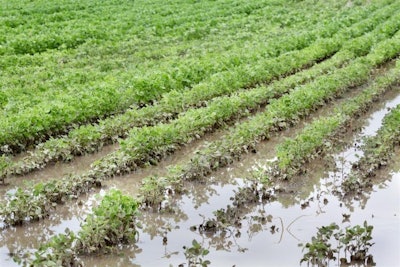
U.S. corn and soybean planting progress remains far behind average, while crop prices soar and protein producers see their stock prices fall.
The U.S. Department of Agriculture’s (USDA) crop progress report for May 27 shows only 58% of the corn crop has been planted, compared with a five-year average of 90%. Soybean plantings are only 29% complete, compared with a five-year average of 66%.
“The Corn Belt is stuck in a weather pattern that’s creating persistent, wet conditions,” said Iowa Secretary of Agriculture Mike Naig in a press release. “This is causing historic planting delays. With only one day suitable for fieldwork last week, corn progress is 10 days behind and soybeans are two weeks behind last year. We know farmers are anxious to get their crops in the field if we get a break from the rain.”
Farmers weighing options
Cool and wet spring weather across much of the corn and soybean acres in the U.S. has hampered planting efforts, and farmers are starting to weigh their options, including crop insurance payouts and possible relief from the USDA. A bill delayed in the U.S. House of Representatives provides the USDA with more than $3 billion for crop losses, including those lost in flooding and crops that were prevented from being planted due to weather.
Agriculture economist Richard Brock said at the American Feed Industry Association Purchasing and Ingredients Suppliers Conference in mid-May that weather has so severely delayed corn planting in many Midwestern states that farmers will either have to plant soybeans instead or rely on crop insurance payouts if they are not able to plant either.
“We’re already so late in Illinois and Indiana, a lot of the acreage is probably going to be switched to soybeans,” he said.
Disaster payments and crop insurance benefits from the Noninsured Crop Disaster Assistance Program (NAP) combined are limited to 90% of a farmer’s loss under the bill. Funding for USDA in the bill includes $558 million for the Emergency Conservation Program and $435 million for the Emergency Watershed Protection Program to help landowners and communities repair damaged infrastructure, according to the National Grain and Feed Association.
Prices affecting protein producers
Planting delays are likely to result in lower yields and lower quality. Corn and soybeans prices surged this week after the USDA released its report, and protein producers including Tyson Foods, Pilgrim’s, JBS and BRF saw their share prices fall.
Morningstar Investment Service analyst Rebecca Scheuneman said in a Bloomberg report that crop price gains “will not overcome the margin improvement we expect to see in protein businesses, because pricing will be so much better with the massive protein shortage” coming due to African swine fever in China, she said.

















